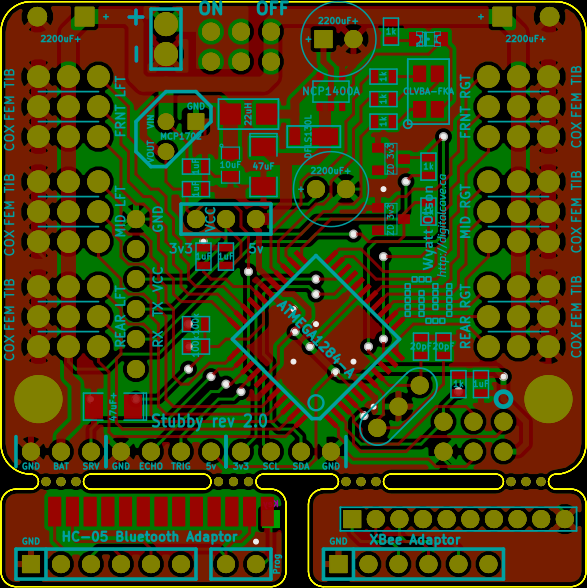I spent a few more hours on the new rev2 design in KiCad. Previously, I had components on the front and the back; I was now able to move all components to the front. (This will make a difference in manufacturing... if you get boards pre-populated from China, apparently it is quite a bit easier (read: cheaper) to have all the components on the same side. Furthermore, it should make things easier for me as well: since I am using a heat gun for reflow soldering, if I had components on the front and the back I would need to do two separate reflows, which would increase the risk of moving components previously soldered or even over-heating components.
I am going to give myself a bit of time to mull over this board, and if there is nothing which I realize needs to be changed, I will submit my order within a week or so.
The latest rev2 board design is below:

To recap from the last log update, I felt the need to change the PCB design from rev1 to address a few shortcomings of the previous board:
- 5v boost regulator (input from a heavily filtered the 3.3v linear regulator) will allow for 20MHz operation (vs. 12 MHz operation in rev1), as well as allowing for 5v peripherals (most notably the ultrasonic range finders)
- Provide explicit pins for the rangefinder plus an extra servo to let the robot 'look' up and down (tilt the rangefinder)
- Breakaway adaptors for both XBee and Bluetooth radios, so there is no need to buy the Sparkfun XBee adaptor
- A more standard pinout for the serial connection: rather than using the 10 pin XBee connection (adapted from 2mm to 100mil spacing), I now use the 6 pin FTDI pinout (and include a jumper to configure whether the serial port is powered at 5v or 3.3v). This saves some board space, and would simplify debugging as I can simply plug in a cable rather than messing about with RF modules.
- A bit of space between each leg's servo connectors (they all fit on the rev1 board, but it gets tight)
- Board space for additional capacitors on both servo power supply rails as well as the 5v and 3.3v rails (vs. nothing on rev1, and haphazardly placed components on the semi-official rev1.1)
The main disadvantage is that it is a lot harder to solder (reflow soldering is pretty much a requirement for this board, which unfortunately moves it out of the entry-hobbyist range).
(For those who have made their own robots using a rev1 board, no need to worry... I plan to keep support in the codebase for rev1 for the foreseeable future. The main advantages of rev2 are in relation to Bluetooth / computer control, for my Hackaday Prize project. If you are controlling Stubby by hand using the Universal Controller, rev1 does everything that rev2 will do).
 The Big One
The Big One
Discussions
Become a Hackaday.io Member
Create an account to leave a comment. Already have an account? Log In.